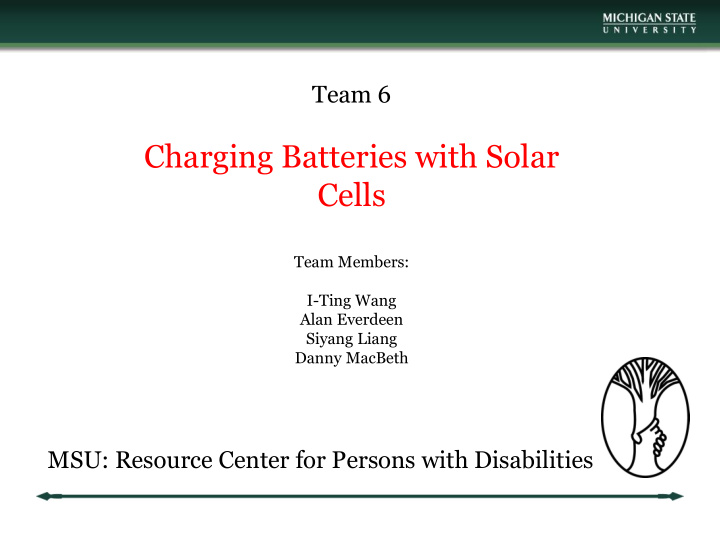



Team 6 Charging Batteries with Solar Cells Team Members: I-Ting Wang Alan Everdeen Siyang Liang Danny MacBeth MSU: Resource Center for Persons with Disabilities
Solar Cell Assembly
Pros and Cons Pros • It is a lot cheaper if you build a solar panel than buying one. • The ouput voltage and current can be customized based on the needs. • The size can also be designed based on the location the panel is needed. Cons • The assembly is extremely time consuming and the solar cells are very fragile. • If the solar cells are not correctly installed the efficiency of the solar panel can be much lower than expected.
Parts and Tools • Flux Pen • Tab Wire (flux wire) • Soldering Station • Rubber Gloves
Overview Charging Controller
Solar Panel • To use a charging controller, a solar panel of 5W or more is required. Why? • Prevent the overcharging of the battery. • Increase the efficiency of the charging. • Prevent current from flowing to the solar panels from the battery.
Charging Time • Deep Cycle Battery rated 60AH ~ 120AH • Solar Panel rated at 90 W, 12 V, 7.5A • Charging Time = 60AH/7.5Amp = 8 Hr • Doubled batteries = Doubled Charging Time • Doubled Solar Panel = Half Charging Time
Storing Charge The best choice to store charge are Deep Cycle Batteries • Low Cost • Easily Available • Excellent Discharge Characteristics • Simple to Expand Capacity
Charging a Battery
Increasing Charge Capacity • Accomplished by adding cells in parallel • All cells must be the same voltage • Adding batteries does complicate charging
Simple Case : One Battery i Total 14 V 10 V < V x < 14 V (Solar)
Parallel Case i Tota l i w i y i x i z V y V z V w V x
Limitations • Mainly used for small scale solar projects • Method feasible for larger scale projects despite better alternatives
Recommend
More recommend